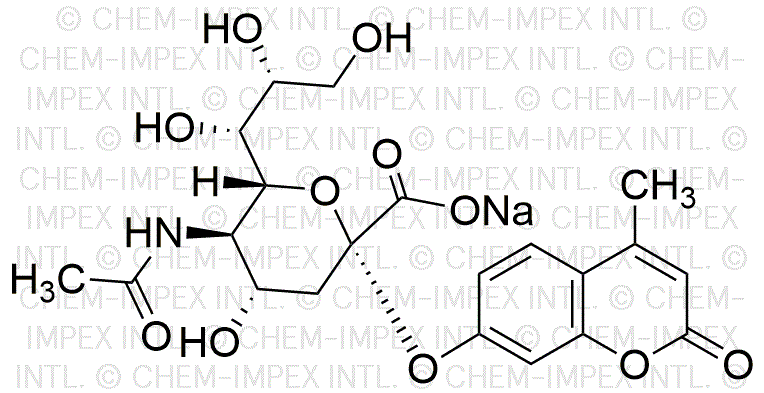2'-(4-Methylumbelliferyl)-a-D-N-acetylneuraminic acid sodium salt is widely utilized in research focused on:
- Enzyme Activity Assays: This compound serves as a substrate for sialidase enzymes, allowing researchers to measure enzyme activity in various biological samples, which is crucial for understanding metabolic pathways.
- Cell Biology: It is used in cell culture studies to investigate the role of sialic acids in cell recognition and signaling, providing insights into cellular interactions and immune responses.
- Diagnostic Applications: The compound can be employed in diagnostic kits to detect sialidase activity in clinical samples, aiding in the diagnosis of certain diseases, including viral infections.
- Biotechnology: In the field of biotechnology, it is utilized for the development of sialylated glycoproteins, which are important for vaccine development and therapeutic proteins.
- Research on Glycobiology: This chemical plays a significant role in glycobiology research, helping scientists understand the structure and function of glycoproteins and their impact on health and disease.
Informations générales
Propriétés
Sécurité et réglementation
Applications
2'-(4-Methylumbelliferyl)-a-D-N-acetylneuraminic acid sodium salt is widely utilized in research focused on:
- Enzyme Activity Assays: This compound serves as a substrate for sialidase enzymes, allowing researchers to measure enzyme activity in various biological samples, which is crucial for understanding metabolic pathways.
- Cell Biology: It is used in cell culture studies to investigate the role of sialic acids in cell recognition and signaling, providing insights into cellular interactions and immune responses.
- Diagnostic Applications: The compound can be employed in diagnostic kits to detect sialidase activity in clinical samples, aiding in the diagnosis of certain diseases, including viral infections.
- Biotechnology: In the field of biotechnology, it is utilized for the development of sialylated glycoproteins, which are important for vaccine development and therapeutic proteins.
- Research on Glycobiology: This chemical plays a significant role in glycobiology research, helping scientists understand the structure and function of glycoproteins and their impact on health and disease.
Documents
Fiches de données de sécurité (FDS)
La FDS fournit des informations de sécurité complètes sur la manipulation, le stockage et l’élimination du produit.
Spécifications du produit (PS)
Le PS fournit une description complète des propriétés du produit, notamment sa composition chimique, son état physique, sa pureté et les exigences de stockage. Il détaille également les plages de qualité acceptables et les applications prévues du produit.
Certificats d'analyse (COA)
Recherchez des certificats d'analyse (COA) en saisissant le numéro de lot du produit. Les numéros de lot et de lot se trouvent sur l'étiquette d'un produit, après les mots « Lot » ou « Lot de fabrication ».
Numéro de catalogue
Numéro de lot/série
Certificats d'origine (COO)
Ce certificat d'exploitation confirme le pays dans lequel le produit a été fabriqué, et détaille également les matériaux et composants utilisés et s'il est issu de sources naturelles, synthétiques ou autres sources spécifiques. Ce certificat peut être requis pour les douanes, le commerce et la conformité réglementaire.
Numéro de catalogue
Numéro de lot/série
Fiches de données de sécurité (FDS)
La FDS fournit des informations de sécurité complètes sur la manipulation, le stockage et l’élimination du produit.
DownloadSpécifications du produit (PS)
Le PS fournit une description complète des propriétés du produit, notamment sa composition chimique, son état physique, sa pureté et les exigences de stockage. Il détaille également les plages de qualité acceptables et les applications prévues du produit.
DownloadCertificats d'analyse (COA)
Recherchez des certificats d'analyse (COA) en saisissant le numéro de lot du produit. Les numéros de lot et de lot se trouvent sur l'étiquette d'un produit, après les mots « Lot » ou « Lot de fabrication ».
Numéro de catalogue
Numéro de lot/série
Certificats d'origine (COO)
Ce certificat d'exploitation confirme le pays dans lequel le produit a été fabriqué, et détaille également les matériaux et composants utilisés et s'il est issu de sources naturelles, synthétiques ou autres sources spécifiques. Ce certificat peut être requis pour les douanes, le commerce et la conformité réglementaire.


